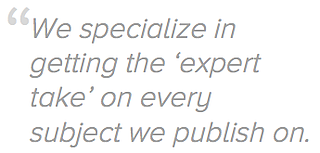 Harvard Business Review is a hallmark of high quality journalism. Each day, the folks at HBR.org publish five to seven pieces of top-notch content with a staff of fewer than 10 full-time digital editors and no full-time writers -- and they have over four million unique visitors reading their content every month.
Harvard Business Review is a hallmark of high quality journalism. Each day, the folks at HBR.org publish five to seven pieces of top-notch content with a staff of fewer than 10 full-time digital editors and no full-time writers -- and they have over four million unique visitors reading their content every month.
Today, more and more companies are creating and hiring for corporate blogs that cover topics target buyers are interested in. Brand journalism, corporate journalism, corporate media, whatever you want to call it -- the content on these blogs is attracting and engaging an audience of potential customers.
So when it comes to building a corporate newsroom, why not learn from the people who do it best? To get the inside scoop of how the HBR newsroom works, we had the pleasure of speaking with web team's editor, Katherine Bell. In our interview (transcribed below), she tells us about HBR's editorial process, what constitutes an "HBR-worthy" topic, how they keep track of all the moving parts, and how they find time to experiment and innovate.
Q: Who is HBR's core audience?
 A: We think mainly of executives and managers when we choose what to publish, but our content is actually useful for a global audience of ambitious professionals. Over half of our audience is outside the U.S.
A: We think mainly of executives and managers when we choose what to publish, but our content is actually useful for a global audience of ambitious professionals. Over half of our audience is outside the U.S.
We've found that a significant amount of our traffic comes from social media, which means people find our content useful and are sharing it a lot. We have about four million unique visitors each month, and at least 45% of that comes from social media, including dark social like email and apps. Even before social media, we found that our content was being shared a lot, but that behavior has only increased with social media.
Our most shareable content is directly relevant to the daily experience of being at work. It's the personal stuff -- pieces about managing yourself and your team, about handling the daily challenges of the workplace. Sometimes, as people move up in their careers, it becomes harder for them to talk to their friends and colleagues in real life about the challenges they hit at work. At some point, it's hard to admit you're having a problem, and you have to be careful about what you talk about at work. In those cases, it can be really helpful to go somewhere you trust and get opinions from experts about how to solve these problems.
Q: What makes a topic "HBR-worthy"?
A: We choose any topics that help people:
- Do their jobs better;
- Know and run their businesses better;
- Understand something new about the context in which they're doing business;
- Understand the forces that are changing business right now;
- Be aware of the new ideas coming out of academia that are relevant to management; and
- Understand which management ideas are behind business stories in the news.
To choose these topics, we have a team of editors who stay on top of new ideas and new research and the experts behind them. The majority of our pieces are expert-written and edited by our editors in-house. In addition to that HBR.org team, HBR's magazine and book editors all contribute to online content as well.

We often use news about interesting companies doing interesting things to connect real-life situations to the theories and principles happening behind them. We don't just report the business news -- we help people in business understand what's important and what it means for them.
We've been doing a lot of coverage of brand new research recently because our audience tends to want to be ahead of everyone else and have the next new idea. These pieces perform really, really well. A lot of other media companies are doing more coverage of new research lately too, but we try to go one step further than them. We'll explain what the new research means, but we'll also explain why it's important in the context of management. We reach out to the researcher and ask them questions our readers might have, and we push the researcher to explain their findings in a way that's accessible.
But no matter what, we specialize in getting the "expert take" on every subject we publish on. It used to be that that expert was also the author of every piece. When we wanted to do something quickly, it meant finding the right management thinker who had the time and way of thinking to be able to respond very quickly. But that was really difficult to manage because sometimes the person with the most relevant idea can't turn around a piece quickly, and researchers aren't always sure how to articulate what is relevant about their research to people outside academia.
So, we've been working hard to come up with other formats -- other ways to translate experts' ideas in different ways. The result is faster turnaround and access to more of the good ideas out there. We've also begun focusing more of our content around themes. Some of these themes are the big shifts changing management. Others are the perennial challenges managers and businesses face -- managing relationships, creating sustainable business models, and so on. We're always looking for different ways to frame those problems, and for new ideas for our readers to try in their own businesses. So we balance our content across these three horizons of importance: what's important to our readers this week, this year, and all the time.
Q: How much experimentation does HBR do?
A: A lot -- we take experimenting very seriously. We set goals every quarter for the new formats we want to experiment with. Examples of formats are certain kinds of editor-reported and -written pieces, question-and-answer pieces, video formats, and interactive graphics. Every quarter, we narrow down the list of formats we want to try -- which we've usually been talking about over the last quarter -- and we have reasons for the ones we pick. Then, we set big goals and try really hard to meet them. We don't always meet all of them. But we always circle back and learn from those things, keep a lot of data, and look at performance both quantitatively and qualitatively. By qualitatively, I mean how we felt about the piece, the quality, and what was achieved, as well as how long it took, how hard it was, and whether we felt it was worth it in terms of traffic and engagement. At the end of the quarter, we do it all over again.
We also have digital ideas meetings twice a week, which are really fun. There are often 20 people at these meetings, and they're mostly editors from across the HBR group -- including people whose primary jobs are in books and the magazine, but who also work on digital content. We talk about anything that's been happening in the world since the last meeting that we could do a piece on. For each subject, we'll discuss which angle to take, which experts we might consult, and the format it should be in, whether it's expert-written, an interview, or interactive. We'll also talk about the big themes we're focusing on at the moment and about recent research.
We have a lot of conversations over email, too. And about a year and a half ago, the web team switched to an open office setup, which has made it easier to be collaborative, which is really, really fun. And it's increased the quality of our pieces as well.
Q: What goes into an article from start to finish?
A: The editorial process varies a ton from piece to piece. It really depends on how quickly we're trying to get it done. Often, we have the luxury of being able to take our time on pieces, and we can adjust to the schedule of the expert involved. We're also doing many more graphics and charts in-house these days, and those take some time. Our editors are constantly juggling different pieces along with other things like our site redesign. Because of all these variables, we end up shifting deadlines on a day-to-day basis. If something needs a 24-hour turnaround, we'll make it happen -- like our Market Basket piece, for example. All of our editorial content on overarching trends gets intensive focus, so we plan that weeks or months out.
We use Trello to manage and keep track of everyone's projects and new ideas. We're constantly trying to improve on all these processes, and it seems like we're always trying to keep up with our record-keeping and organizational processes, but they're never quite caught up. But Trello helps a lot -- we love Trello. We have one board for digital ideas, which goes up on the screen during those digital ideas meetings twice a week. We have a few other reference boards with calendars, another board for themes, and another board for editorial work for our site redesign. The HBR magazine is using it for some of their tracking and integration with our team's projects, too. And lots of us use it for our personal to-do lists, too.
Q: What about guest contributors?
A: We recently rewrote our guidelines for guest contributors to make it very clear what we're looking for. In short, we look for five principles: expertise, evidence, original thinking, usefulness, and writing that's persuasive and a pleasure to read.
We get a huge number of guest contributors pitching to us every day, and being rigorous about deciding what to publish is tricky. We've tried to become more selective over the years. We get plenty of guest contributions that are good enough, that make a good point and may be useful, and it's hard to say no to that stuff, especially from authors we already have a relationship with. Learning to reject even more when we like something, so that we have enough time to look for new authors and work on experimental content, is something we're working on. Going out and looking for new authors with potential who we may not have heard of, but that takes a lot of time. We're always trying to make sure we're finding as many new ideas as we can. The hard part is making those cost-benefit analyses all the time and constantly figuring out the right place to draw the line.
Blogging




![HubSpot's 2025 State of Blogging Report [Data from 500+ Marketers]](https://53.fs1.hubspotusercontent-na1.net/hubfs/53/untitled-design-4-67880d8b2a3db.webp)





![The Top 3 Reasons Consumers Read Blogs & How to Attract Them [New Data]](https://53.fs1.hubspotusercontent-na1.net/hubfs/53/202_Reasons-Consumers-Read-Blogs.png)

